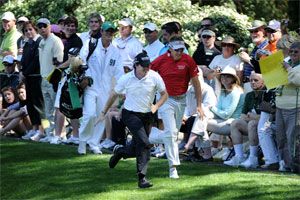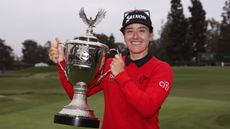The par 3 Contest
Fergus has been down catching the action at The Masters' famous par 3 competition.


I've been down to spend an hour and a half watching the par 3 contest. I wasn't quite right about six hours at the end of my last entry, but the players will be teeing off until 5pm. So there's plenty of action still going as I write this.
At this stage, one of my favourites for the week Luke Donald leads the way with a score of 22. That's five-under-par. Could he be the first man to break the famous "jinx?"
In the planning of Augusta National, inaugural chairman Clifford Roberts wanted to include a short course in addition to the main track. Bobby Jones was less enthused by the idea though it was the club's post-depression finances that dictated the plan was shelved.
The project was only shelved though and, in 1958, Roberts hired course architect George Cobb to build nine par 3 holes around two ponds close to the clubhouse. For Roberts, renowned as a perfectionist, this short course was an essential component of the club and something he felt had been omitted from the original designs.
In 1960, Roberts announced a par-3 contest around the short course on the Wednesday afternoon prior to The Masters. The first par 3 tournament was won by Sam Snead who negotiated the pristine track in just 23 strokes - the course record is 20, shared by Art Wall and Gay Brewer.
Since 1960 the par-3 competition has become a Masters tradition - a grand spectacle and perfect warm-up to the main event. It's a celebration of golf where Masters patrons have a chance to see tournament participants, non-competing past champions, and honorary invitees in relaxed mood enjoying the company of their peers, families and the people who come to support them.
The event is just as colourful and fun-filled as I would have expected. The setting of the little course is, if anything, more beautiful than the main track. The shirts of the spectators and the flowering azaleas are reflected in the flat calm water of the ponds and a wonderful array of trees and shrubs surround the holes.
Get the Golf Monthly Newsletter
Subscribe to the Golf Monthly newsletter to stay up to date with all the latest tour news, equipment news, reviews, head-to-heads and buyer’s guides from our team of experienced experts.
I followed Rory McIlroy, Tom Watson and Ian Poulter for the majority of their round and my analysis would be this - Poulter needs to work on his distance control a little, McIlroy gets too much spin and Watson was looking rather shaky on the five footers. Poulter and McIlroy got the fans going with a little foot race along the side of the pond towards the ninth green. I think McIlroy won but, technically, the pair should have been ejected from the premises. There's supposed to be no running at Augusta.
I stayed to see three legends, Jack Nicklaus, Arnold Palmer and Gary Player complete their rounds. Palmer played a great tee shot to the last that ended some 15 feet beyond the pin. As much as I, and the thousands around the final green, tried we couldn't will Arnie's ball into the hole for a closing birdie. It was cool to see them though and fantastic to feel the patrons' appreciation for the modern era's great triumvirate.

Fergus is Golf Monthly's resident expert on the history of the game and has written extensively on that subject. He is a golf obsessive and 1-handicapper. Growing up in the North East of Scotland, golf runs through his veins and his passion for the sport was bolstered during his time at St Andrews university studying history. He went on to earn a post graduate diploma from the London School of Journalism. Fergus has worked for Golf Monthly since 2004 and has written two books on the game; "Great Golf Debates" together with Jezz Ellwood of Golf Monthly and the history section of "The Ultimate Golf Book" together with Neil Tappin , also of Golf Monthly.
Fergus once shanked a ball from just over Granny Clark's Wynd on the 18th of the Old Course that struck the St Andrews Golf Club and rebounded into the Valley of Sin, from where he saved par. Who says there's no golfing god?
-
 JM Eagle LA Championship Prize Money Payout 2024
JM Eagle LA Championship Prize Money Payout 2024There’s a record purse for a regular-season LPGA Tour event at Wilshire Country Club
By Mike Hall Published
-
 ‘I Think I Can Be Helpful’ – Rory McIlroy Opens Up On Potential Return To PGA Tour Policy Board
‘I Think I Can Be Helpful’ – Rory McIlroy Opens Up On Potential Return To PGA Tour Policy BoardThe four-time Major winner resigned from the board six months ago, but with the game still fractured, he could be about to return
By Mike Hall Published